Morphology and properties of nanocermet thin films
Thin composite films containing metal nanoparticles in a ceramic matrix (known as nanocermets) are of interest for the development of new photonic devices. Nanocermets are particularly important for solar energy conversion in that they tend to exhibit large absorption cross sections near ultraviolet visible (UV-VIS) frequencies. Optical properties of these nanocermet films are however, not only related to the size, but also to the shape and distribution of the nanoparticles in the matrix. Thus by tuning the size, shape and volume fraction or distribution of nanoparticles in a matrix one can tune the absorption frequency of the material. It is therefore of continuing interest to study the morphology and the optical properties of the films and to correlate these to tailor microstructure to achieve the desired materials properties.
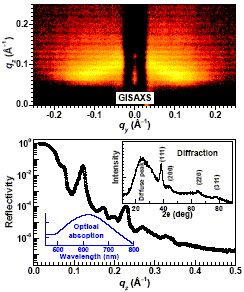
The morphology of nanocermet films is usually determined by electron microscopy, which gives direct but local information. However, a more appropriate approach to describe their morphology would be a statistical one. Furthermore, to correlate the structure or morphology with their optical properties it is highly desirable to study the same sample without modification or destruction. Surface sensitive X-ray scattering techniques enable the statistical determination of the morphology of thin films in a nondestructive way. Specular reflectivity provides the structure of a film along the growth direction while grazing incidence small angle X-ray scattering (GISAXS) provides the average size, shape and distribution of nanoparticles in the matrix. The combination of reflectivity and GISAXS yields the complete morphological information of the system, which can then be compared with the optical properties [see publication Appl. Surf. Sci. 253, 2154 (2006)]. In this project our research plan was to use X-ray scattering techniques in determination of the morphology of nanocermet thin films grown by sputter deposition technique. The optical properties of the films will then be studied which will be compared with the morphology.
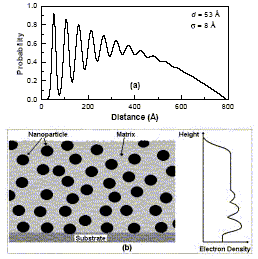
The morphology of ceramic-metal nanocermet thin films is studied by surface sensitive X-ray scattering techniques. GISAXS experiments carried out at LURE with a 2D detector show that metal clusters of nanometer size, known as nanoparticles, are dispersed in the thin film. Analyses of the X-ray reflectivity along with the diffuse scattering allow to predict the formation of layers of nanoparticles along the growth direction of the films. The formation of such cumulative disordered layers in one direction is likely to be related to the boundary condition in the reduced dimension [published in Physica B 283, 97 (2000)].
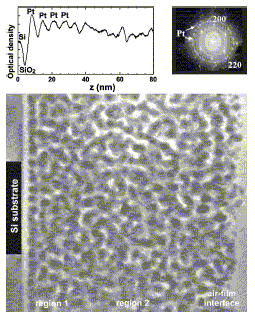
Experiments performed by X-ray reflectivity, GISAXS and transmission electron microscopy (TEM) on a cosputtered nanocermet thin film of Pt-Al2O3 show that the morphology of such a heterogeneous material can be well interpreted by combining the information obtained from the three techniques. In particular, the layering of metal nanoparticles in the immediate vicinity of the substrate is clearly evidenced. GISAXS results are interpreted via a model which yields spherical nanoparticles of diameter, 2R = 3.1 nm, separated on the average by a distance of 5.8 nm. The evidence for the layering of particles close to the substrate is deduced form the analysis of the specular reflectivity and probed directly by TEM [published in Phys. Rev. B 63, 193407 (2001)].
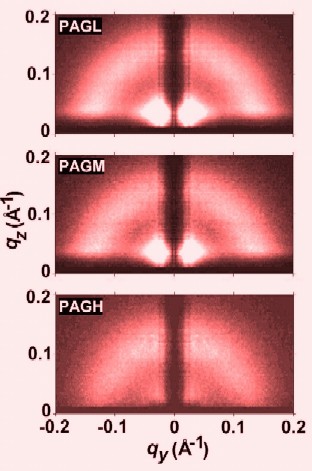
Morphology of Pt-Al2O3 nanocermet thin films deposited on substrates having different roughness has been studied by surface sensitive X-ray scattering techniques. GISAXS data of the films shows that the nanoparticles, which are present in the ceramic matrix, exhibit a specific average interparticle separation. Analysis of the X-ray reflectivity indicates that in the films deposited on smooth substrates, the nanoparticles adopt some layering along the growth direction. This layering tends to diminish with increasing substrate roughness and vanish completely for very high substrate roughness. The variation of such layering with substrate roughness is an indication that it starts close to the substrate and is an effect of substrate boundary condition [published in J. Phys. D 34, 1575 (2001)].
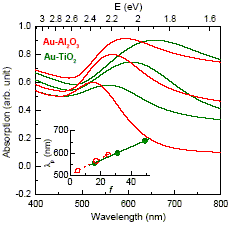
The morphology of Au-Al2O3 nanocermet thin films, prepared by cosputtering Au and Al2O3 on float glass substrates was studied using surface sensitive X-ray scattering techniques and the results were correlated with the optical absorption of the films measured using ultraviolet visible spectroscopy. The presence of gold nanoparticles in an alumina matrix is evident from both X-ray scattering and spectroscopic studies. The distribution of nanoparticles is obtained from GISAXS, while electron density profile obtained from the analysis of X-ray reflectivity data gives total film thickness, volume fraction (f) of Au and the special arrangement along the growth direction. Optical properties show a linear dependence of the absorption peak position with f, which is interesting for making nanocomposites of tunable absorption [published in Appl. Phys. Lett. 85, 395 (2004)].
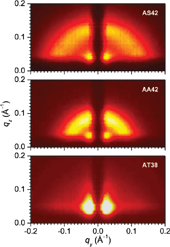
The morphology of the Au-nanocermet thin films of different matrices, but prepared in identical condition have been observed. In particular, the average separation between Au-particles was found in alumina and silica matrices, but not in titanium oxide matrix, also the average separation in alumina matrix is much more than that in silica matrix. The film thickness was found very much different, which is related to the different sputtering yields of the ceramic materials. Volume fraction of Au estimated from the average critical wave vector shows that the total volume or the amount of Au is different in films of different ceramic matrix, which suggests that even the sputtering yield of Au is very much different in presence of different ceramics atmosphere. Interesting differences in the morphology of Au nanoclusters in Au-TiO2 composite system (nanorod like) is observed compared to that in Au-SiO2 and Au-Al2O3 composite systems (nanoparticle like), which may be related to the preferential sputtering yield [published in J. Appl. Phys. 101, 113532 (2007)].
|

